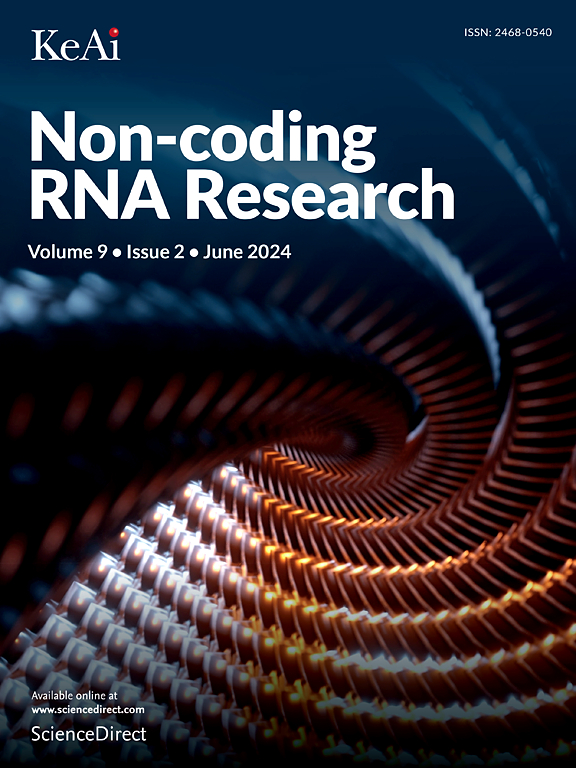Extracellular vesicles derived microRNAs as non-invasive markers of liver fibrosis in chronically infected HCV patients: a pilot study
IF 5.9
3区 生物学
Q1 BIOCHEMISTRY & MOLECULAR BIOLOGY
引用次数: 0
Abstract
Extracellular vesicles (EVs) are an increasingly promising tool for liquid biopsy in liver diseases. Hepatitis C Virus (HCV) infection, alone or together with Human Immunodeficiency Virus (HIV) infection significantly impacts on the microRNA (miRNA) EVs content resembling chronic hepatitis C (CHC) progression. The objective of the study was to delve into the intricate EVs-miRNA profiles in CHC patients with different liver fibrosis stages, aiming to pinpoint non-invasive markers capable of distinguishing significant fibrosis.
Plasma EV-miRNAs from 50 CHC patients (HCV+ and HCV+/HIV+) stratified in no significant (F < 2) and significant (F ≥ 2) fibrosis, were massively sequenced. General linear models (GLM) were used to identify significantly differential expressed (SDE) miRNAs according to liver fibrosis stages (F ≥ 2 and F < 2). Dysregulated biological pathways were subsequently analyzed in silico for the following groups: i) all patients; ii) HCV+; and iii) HCV+/HIV+. Multiple-ordered logistic regression analysis was performed to develop a score to identify F ≥ 2 cases. The diagnostic potential of both the SDE miRNAs and the developed score was assessed using ROC curve analysis.
With respect to all CHC patients, two SDE miRNAs (hsa-miR-122-5p and hsa-miR-92a-3p) were identified which regulate genes related to cytoskeleton organization. Regarding their diagnostic performance to discriminate F ≥ 2, both miRNAs individually demonstrated acceptable diagnostic values. However, their combined use in a new score enhanced their diagnostic performance (AUROC = 0.833).
In the HCV+ subgroup, 8 SDE miRNAs (hsa-miR-122-5p, hsa-miR-320c, hsa-miR-3615, hsa-miR-320a-3p, hsa-miR-374b-5p, hsa-let-7a-3p, hsa-miR-199a-5p, hsa-miR-142-5p), which regulate macrophage activity and cell growth/death regulation, were recognized. Among them, hsa-miR-3615 displayed the highest diagnostic performance to discriminate F ≥ 2 (AUROC = 0.936).
With respect to HCV+/HIV+, 18 SDE miRNAs (hsa-miR-4508, hsa-miR-122-5p, hsa-miR-451a, hsa-miR-1290, hsa-miR-1246, hsa-miR-107, hsa-miR-15b-5p, hsa-miR-194-5p, hsa-miR-22-5p, hsa-miR-20b-5p, hsa-miR-142-5p, hsa-miR-328-3p, hsa-miR-335-3p, hsa-miR-125a-5p, hsa-miR-423-3p, hsa-let-7d-3p, hsa-miR-128-3p, hsa-miR-10a-5p) were recognized that regulate RNA silencing processes. In this case, hsa-miR-423-3p and hsa-miR-128-3p showed outstanding diagnostic performances (AUROC > 0.900).
Distinct EVs-miRNA profiles were identified in patients with varying liver fibrosis stages, both in the overall CHC cohort and within HCV+ and HCV+/HIV+ subgroups. These specific miRNA signatures would allow the elucidation of potential mechanisms involved in clinical evolution and identification of specific biomarkers of unfavorable progression, plausible to be used in a diagnostic panel. Furthermore, the developed score demonstrates the ability to discriminate within the CHC group those individuals with significant fibrosis regardless of their HIV infection status.

求助全文
约1分钟内获得全文
求助全文
来源期刊

Non-coding RNA Research
Medicine-Biochemistry (medical)
CiteScore
7.70
自引率
6.00%
发文量
39
审稿时长
49 days
期刊介绍:
Non-coding RNA Research aims to publish high quality research and review articles on the mechanistic role of non-coding RNAs in all human diseases. This interdisciplinary journal will welcome research dealing with all aspects of non-coding RNAs-their biogenesis, regulation and role in disease progression. The focus of this journal will be to publish translational studies as well as well-designed basic studies with translational and clinical implications. The non-coding RNAs of particular interest will be microRNAs (miRNAs), small interfering RNAs (siRNAs), small nucleolar RNAs (snoRNAs), U-RNAs/small nuclear RNAs (snRNAs), exosomal/extracellular RNAs (exRNAs), Piwi-interacting RNAs (piRNAs) and long non-coding RNAs. Topics of interest will include, but not limited to: -Regulation of non-coding RNAs -Targets and regulatory functions of non-coding RNAs -Epigenetics and non-coding RNAs -Biological functions of non-coding RNAs -Non-coding RNAs as biomarkers -Non-coding RNA-based therapeutics -Prognostic value of non-coding RNAs -Pharmacological studies involving non-coding RNAs -Population based and epidemiological studies -Gene expression / proteomics / computational / pathway analysis-based studies on non-coding RNAs with functional validation -Novel strategies to manipulate non-coding RNAs expression and function -Clinical studies on evaluation of non-coding RNAs The journal will strive to disseminate cutting edge research, showcasing the ever-evolving importance of non-coding RNAs in modern day research and medicine.
 求助内容:
求助内容: 应助结果提醒方式:
应助结果提醒方式:


